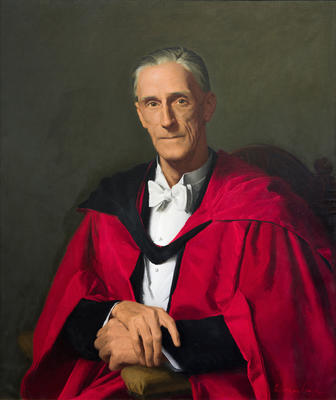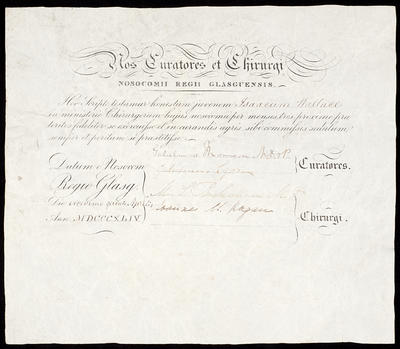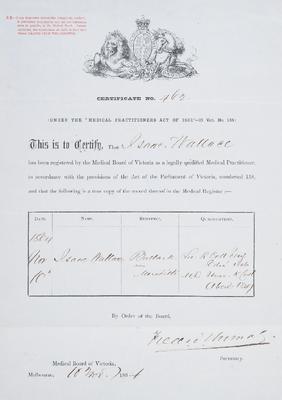Portrait of Sir William W. S. Johnston (1887-1962)
Maker
1. Rex Bramleigh (b.1923, d.2014)
2. William Johnson (b.1887, d.1962)
Date
Circa 1962
Description
Sir William Wallace Stewart Johnston (1887-1962) (William Johnson), physician and army medical officer, second son of William Edward Johnston, a barrister from Scotland who became a county court judge, and Clara Jane, née Wallace. Educated at Melbourne Church of England Grammar School and Trinity College, University of Melbourne (M.B., B.S., 1914; M.D., 1921), he was a resident medical officer at the (Royal) Melbourne Hospital when World War I broke out.
On 14 July 1915 Johnston was appointed captain, Australian Army Medical Corps, Australian Imperial Force. Posted to the hospital ship, Karoola, he sailed for the Middle East in December and was transferred to the 3rd Field Ambulance in Egypt in February 1916. Next month he was sent to the Western Front where he later joined the 12th Battalion as regimental medical officer. In August, at Mouquet Farm, near Pozières, France, he braved an intense barrage to treat the wounded and was awarded the Military Cross. Promoted major in August 1917, he was mentioned in dispatches. At Hooge, east of Ypres, Belgium, he went out in the open in September to attend the wounded where they lay and continued working until he was severely injured by shell-fire. He was recommended for the Victoria Cross but received the Distinguished Service Order. After recovering in England, he rejoined the battalion in February 1918.
Johnston returned to Australia in 1919; his appointment terminated on 27 January 1920. On 3 December 1923 at Scots Church, Melbourne, he married Jessie Mary Clark. Johnston served in the Militia as commander of the 2nd Field Ambulance in 1928-34 and then as assistant-director of medical services at Army Headquarters. He was called up for full-time duty in October 1939 as assistant director-general of medical services.
Almost concurrently, Johnston was seconded to the A.I.F. and placed in command of the 2nd/2nd Australian General Hospital which he took to Palestine in April 1940. As deputy-director of medical services, I Corps, from 25 January 1941, he was initially responsible for the care of Australian troops in Palestine and Libya. By March he was based in Greece, co-ordaining the medical matters of the 6th Australian Division with those of British and New Zealand formations. When the Germans overran the country in April, he was evacuated via Crete to Egypt. He was appointed C.B.E. (1941) for his part in the campaign.
Johnston had overall command of medical arrangements for the operations against the Vichy French in Syria in June-July. Promoted temporary brigadier in August, he returned home in February 1942. Six months later he was in Port Moresby as D.D.M.S., New Guinea Force. In the fighting along the Kokoda Track and beyond, the terrain posed severe problems in evacuating sick and wounded men, and in transporting medical supplies to the front. Strict anti-malaria precautions had to be enforced. Largely due to Johnston’s efforts, the difficulties were finally overcome and he was again mentioned in dispatches. Although he had retained his health, he was not robust and he was sent to Australia in December 'for a spell from the tropics'. Between February and May 1943 he served in North Queensland as D.D.M.S., II Corps. He was placed on the Reserve of Officers on 20 July.
Resuming both his practice and his honorary post at the R.M.H., Johnston was director (1947-56) and chairman (1956-62) of the Melbourne Medical Post-Graduate Committee. In 1947 he was appointed a knight of the Order of St John; in 1957 he became chief commissioner to the St John Ambulance Brigade in Australia. He was a member (1945-52) and medical director (1943-44) of the national council of the Australian Red Cross Society, and vice-president (1958-60) of the Royal Australasian College of Physicians. In 1960 he was knighted. President (1959-61) of the Graduate Union and a council-member (from 1961) of the University of Melbourne, in 1962 he was awarded an honorary LL.D. He had been elected president of the Melbourne Club in 1945.
See full details









Do you know something about this object?
Be the first to comment on this object record.